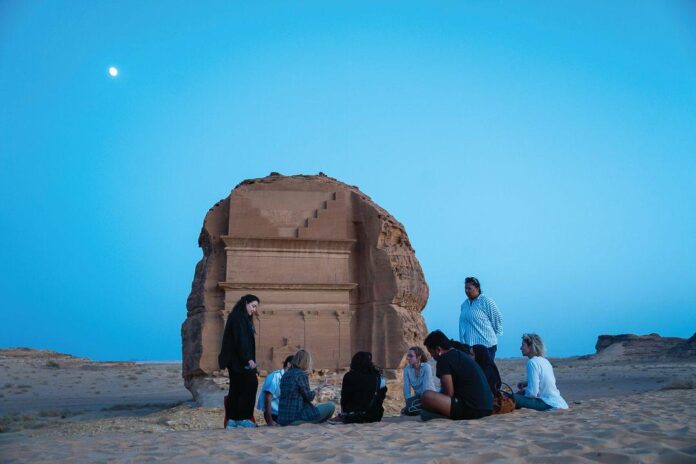The French government agency tasked with developing the heritage region of AlUla in Saudi Arabia is quietly launching artist-led programmes in the vast north-western area of the country, developing projects with a raft of international participants.
The Centre Pompidou in Paris will oversee a museum project in the AlUla region of Saudi Arabia, according to Le Monde newspaper. Specialists from the Paris-based Beaubourg gallery will advise on a new gallery called Perspective Galleries which has been designed by the Lebanese architect Lina Ghotmeh, adds Le Monde. At the time of writing, representatives from the Centre Pompidou had not responded to a request for comment.
The outpost would be the latest addition to the international network of satellites launched by the Centre Pompidou, which runs annexes in Metz in northern France, Shanghai and Malaga.
The proposed Centre Pompidou project is the latest France-driven arts initiative to be launched in Saudi Arabia.
The Afalula agency, founded in Paris in July 2018, is the result of an intergovernmental agreement signed by France and Saudi Arabia. Afalula works in partnership with the Royal Commission for AlUla (RCU), the Saudi government cultural body led by the country’s de facto ruler, Crown Prince Mohammed bin Salman.
“Saudi Arabia and France share a vision to implement a new economic and touristic development model, focused on the absolute preservation of the environment, respectful of history, and inclusive of local populations,” says Gérard Mestrallet, the executive chairman of Afalula, in an online statement.
A French critic, who chose to remain anonymous, says: “The French/Saudi partnership is part of a drive to promote the cultural credentials of Saudi Arabia, helping to diversify the economy and deliver a more ‘open’ image of the country, in line with the government’s Vision 2030 plan.”
During the latest residency programme, six artists spent 12 weeks in a guesthouse and palm grove in AlUla late last year; they included Augustine Paredes, a Filipino artist based in the United Arab Emirates. Other participating artists included Sabine Mirlesse from France, the Emirati scholar and poet Afra Atiq, and two Saudi artists, Mohammad Alfaraj and Daniah Alsaleh.
“I was researching the poetics of farming with the focus on the pain of a palm tree. I spent time in AlUla having conversations with the scientists and researchers based there, observed the farm life and farmers, all while reconnecting with my roots as a child of farmers back in the Philippines,” Paredes tells The Art Newspaper.
Mirlesse developed a divinatory object that retraces the practices of the early Arabs, while Atiq presented a two-part poetic cycle inspired by wādi (valley) and samā’ (sky.) “Each [artist] has, in their own way, paid homage to the marks that the past has left on the landscape, the city and its society, and at times the intriguing absence of traces and, therefore, of narratives,” says a curatorial statement.
Another residency programme was launched last month with the participating artists to be confirmed; an exhibition featuring works from both programmes is due to launch at the AlUla Arts Festival, which begins 16 February.
“The ambition is also to gradually connect the AlUla artists residency programme to the Journey Through Time masterplan’s cultural assets, and explore thematic residencies as multiple acts of prefiguration, such as agriculture, botany and perfume, the Arabian horses, arts in the landscape, design and architecture,” says a spokesman for Afalula.

Augustine Paredes, a Filipino artist who is part of the latest AlUla residency programme, with one of his installations. Courtesy of the artist Hegra; Courtesy of the Royal Commission for AlUla and Afalula
The Journey Through Time masterplan is centred around the old town of AlUla and the Cultural Oasis, where archaeological, anthropological, botanical and genetics research is being conducted on ancient architecture, agriculture and water resources.
Iwona Blazwick, the chair of the RCU Public Art Expert Panel, says in a statement: “The ambition [of the artist residency programme] is two-fold: to create dialogue that transcends geo-politics and cultural differences, and to see what happens when you invite someone from outside into this rich environment.”
Last year, Blazwick defended her new post in light of Saudi Arabia’s concerning record on human rights. “I’d rather be involved where I can help contribute to freedom of expression, to art being nurtured, because I believe art changes society. That’s fundamental to who I am. And it’s fundamental to my support for women throughout my career,” she said.
Broader cultural context
However, the ways that freedom is developing in the notoriously orthodox kingdom is complex. Platforms that have sprung up, from biennials to heritage initiatives, have given Saudi artists much more exposure, drawing international figures to the kingdom keen to discover the rich seam of excellent women artists working there. A Middle Eastern curator, who believes Saudi Arabia is evolving rapidly in relation to neighbouring states, says that Saudi Arabian artists are not free but “I do think they are freer”.
Last month Sophie Makariou, the former president of the Musée Guimet in Paris, was named the scientific director responsible for the culture and heritage division (archaeology, contemporary art and museums) of Afalula; she replaces Jean-François Charnier, who stood down last September.
Just one day after Turkish officials announced that the journalist Jamal Khashoggi had been murdered in the Saudi consulate in Istanbul on 7 October 2018, France’s president, Emmanuel Macron, issued a decree officially confirming the cultural development of AlUla province. The budget for the joint project is believed to be at least $20bn.
The proposed network of future museums and archaeological sites around a museum of Arabic civilisation at the AlUla site follows the launch of Louvre Abu Dhabi in November 2017, another vast Middle Eastern project supported by the French government. The Emirati government paid €1bn for the Louvre’s brand and expertise (the loan of the Louvre name is for a period of 30 years and six months).
• The book Censored Art Today by Gareth Harris (Lund Humphries) discusses further the sociopolitical situation in Saudi Arabia.

























